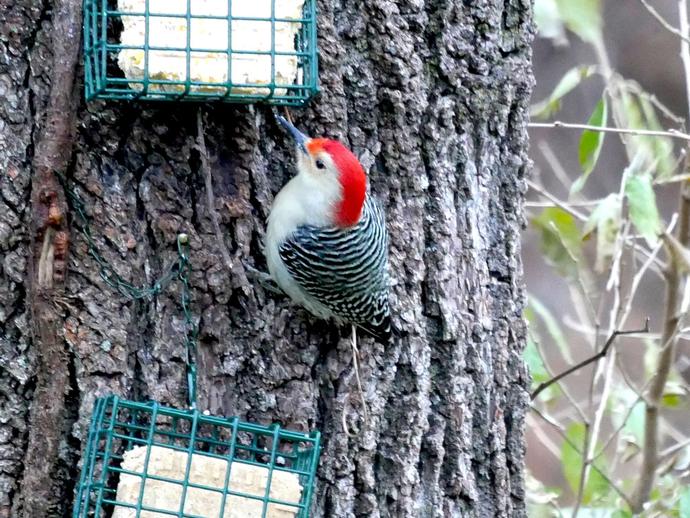December 8, 2020
The red-bellied woodpecker (Melanerpes carolinus) is one of our most beautiful woodpeckers, and it can be found pretty commonly across the eastern half of the United States. You might be tempted to call this a red-headed woodpecker, given that its most prominent feature is its bright red head (which is especially striking in the males of the species, such as this one). However, the red-headed woodpecker (Melanerpes erythrocephalus) looks quite different and is harder to find in southwest Virginia. For what it's worth, red-bellied woodpeckers do have a faint reddish tint on a small part of their bellies. If you squint.
Red-bellied woodpeckers mainly eat insects hiding under the bark of trees, but they'll also eat fruits, nuts, and seeds. They use their beaks to hammer into bark or probe crevices on trees for bugs. Their efforts are aided by a sticky, barbed tongue that can extend a full two inches past the tips of their beaks! Males have broader, longer tongues than females, which allows breeding pairs of woodpeckers to forage in different areas and maximize their productivity. Teamwork makes the dream work! Woodpeckers will also stash food inside cracks in trees to save for later, which is a habit shared by several woodpeckers in the genus Melanerpes.
In what's quickly becoming a recurring theme in these nature posts, dead trees are hugely important to red-bellied woodpeckers and many other animals. While it may be tempting to clear out all the dead trees on your property, you may want to leave them if you like having woodpeckers around. In areas that have been extensively deforested, red-bellied woodpeckers quickly become scarce. Nesting holes are precious to red-bellied woodpeckers and they've been known to chase off smaller tree-nesting birds. Unfortunately, they're more often the victims of the invasive European starling (Sturnus vulgaris), which frequently chases away red-bellied woodpeckers to steal their nesting holes.
If you'd like to attract red-bellied woodpeckers to your home, you can't go wrong with a suet feeder like the one in the photos (as you can see, I bought two new suet feeders after some mischievous critter absconded with my old one). They especially rely on suet feeders in the winter, as do many other woodpeckers and tree-climbing birds.
ABOUT #BenInNature
Social distancing can be difficult, but it presents a great opportunity to become reacquainted with nature. In this series of posts, Administrator of Science Ben Williams ventures outdoors to record a snapshot of the unique sights that can be found in the natural world. New updates are posted Monday - Friday, with previous posts highlighted on the weekends.
NEW: TRIVIA CHALLENGE
You've seen the posts. You've learned the facts. Now, it's time to prove you are a #BenInNature Mega Fan! The museum's education team has developed the #BenInNature Trivia Challenge to identify the most devoted fans out there! Everyone who successfully answers each trivia question correctly will be congratulated by having your own nature selfie posted to the museum's #BenInNature Mega Fan Photo Album on the official VMNH Facebook page! Learn more and download the trivia challenge today by visiting www.vmnh.net/research-collections/beninnature-trivia-challenge.
NATURE PHOTO IDENTIFICATIONS
If you discover something in nature that you would like help identifying, be sure to message us right here on Facebook with a picture (please include location and date of picture) and we'll have our experts help you identify it!

 Hours & Admissions
Hours & Admissions Directions
Directions

